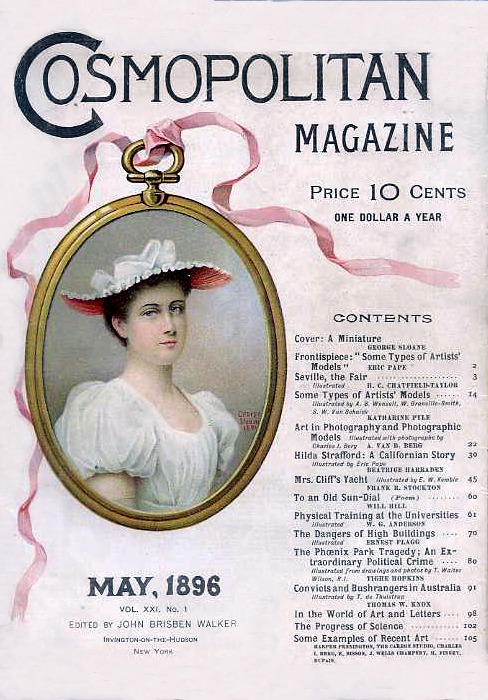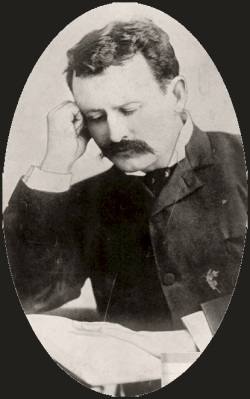|
John Brisben Walker
John Walker laid out what would later become the West Side
The article above is slightly incorrect. Walker didnt found Cosmo, but he did buy it in it's infincy and turned it into a powerhouse magazine for women and later sold it at a huge profit. However, the Cosmo he developed was nothing like the magazine sold today. I'm guessing that Walker is turning over in his grave about now.
Hisory of the near West Side.... By GEORGE W. SUMMERS
Later Mr. Walker interested Nicholas J. Bigley, of Allegheny county, Pa., meaning either the city of Pittsburgh or one of its suburbs, and the two laid out and began the promotion of the Bigley and Walker addition, which later was known as Glen Elk. It comprised the territory in the Elk valley north of the present West Washington street. The third section grew up in later years between the western end of the old West Charleston and Two Mile creek, and is now a flourishing and thickly settled portion of the city, with residences, stores, churches, school houses and manufacturing plants. The section afterwards known as Glen Elk was laid out and promoted by Bigley and Walker. The present Bigley avenue was named for Mr. Bigley, but the name of J. k Brisben Walker who was the real founder of the whole West Side of today, is not preserved in any way in any portion of the city. Bigley and Walker based their hopes of a new city in the Elk valley, north of what was then East Charleston street and now is West Washington street, on an industry trial section they hoped to establish in that territory. And their first act in promoting the sale of home sites was to arrange for the building of a blast furnace. It was planned that it should utilize the iron ore which cropped out from the hills in the valley of Magazine Creek (Magazine Hollow) and the surrounding territory. There is still iron ore in these hills, but neither its quantity nor its quality would permit it to enter into successful competition with the rich ores from Minnesota.
Walker's Wife: Author Mr. Walker's wife was Emily, daughter of D.H. Strother, artist and writer of the early 1800's, who wrote under the name of "Porte Crayon." Her early volume on what was then a wilderness country along the western slope of the Allegheny mountains is fine in its descriptions and valuable for its illustrated accounts of the early country now in West Virginia. While the blast furnace never was completed and consequently never gave employment to any one except the comparatively few who aided in its construction, the town planned by Bigley and Walker, to be based on the iron industry which it was thought would follow the iron furnace, grew from other reasons and based on other industry. Glen Elk, as the Bigley and Walker addition came to be known, developed numerous saw and planing mills, a veneer factory and other wood working industries, and gradually grew into a town of considerable size. The first post office on what is now the West Side was called Glen Elk. Later, Glen Elk and the "West End" were incorporated into a city known as "Elk City," which still later was merged into Charleston and is now part of the greater city.
MORE ON THE COSMOPOLITATION MAGAZINE
Cosmopolitan began as a family magazine, launched in 1886 by Schlicht & Field as The Cosmopolitan. Paul Schlicht told his first-issue readers that his publication was a "first-class family magazine", adding, "There will be a department devoted exclusively to the interests of women, with articles on fashions, on household decoration, on cooking, and the care and management of children, etc., also a department for the younger members of the family." Cosmopolitan's circulation reached 25,000 that year, but by March, 1888, Schlicht & Field were no longer in business. John Brisben Walker acquired the magazine in 1889, and E. D. Walker, (no relation) formerly with Harper's Monthly, took over as the new editor, introducing color illustrations, serials and book reviews. It became a leading market for fiction, featuring such authors as Annie Besant, Ambrose Bierce, Theodore Dreiser, Rudyard Kipling, Jack London, Willa Cather and Edith Wharton. The magazine's circulation climbed to 75,000 by 1892. In 1897 Cosmopolitan announced plans for a free correspondence school: "No charge of any kind will be made to the student. All expenses for the present will be borne by the Cosmopolitan. No conditions, except a pledge of a given number of hours of study." When 20,000 immediately signed up, Walker could not fund the school and students were then asked to contribute 20 dollars a year. Also in 1897, H. G. Wells' The War of the Worlds was serialized, as was his The First Men in the Moon (1900). Olive Schreiner contributed a lengthy article about the Boer War. In 1905 William Randolph Hearst purchased the magazine for $400,000 (approximately $11,000,000 in 2007 prices)
John Walker built a home in 1909 atop
Mt. Falcon (a mountain slightly west of Denver, Colorado). The house
was struck by lightning and was ruined in 1918. He attempted to build
a summer white house for the
See the map the Walker plotted HERE
|





